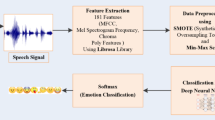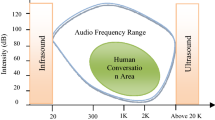Abstract
The paper analyzes the prosody features, which includes the intonation, speaking rate, intensity, based on classified emotional speech. As an important feature of voice quality, voice source are also deduced for analysis. With the analysis results above, the paper creates both a CART model and a weight decay neural network model to find acoustic importance towards the emotional speech classification and to disclose whether there is an underlying consistency between acoustic features and speech emotion. The result shows the proposed method can obtain the importance of each acoustic feature through its weight for emotional speech classification and further improve the emotional speech classification.
Access this chapter
Tax calculation will be finalised at checkout
Purchases are for personal use only
Preview
Unable to display preview. Download preview PDF.
Similar content being viewed by others
References
Campbell, N.: Perception of Affect in Speech - towards an Automatic Processing of Paralinguistic Information in Spoken Conversation. In: ICSLP 2004, Jeju (October 2004)
Tao, J.: Emotion control of chinese speech synthesis in natural environment. In: EUROSPEECH 2003, pp. 2349–2352 (2003)
Gobl, C., Chasaide, A.N.: The role of voice quality in communicating emotion, mood and attitude. Speech Communication 40, 189–212 (2003)
Scherer, K.R.: Vocal affect expression: A review and a model for future research. Psychological Bulletin 99, 143–165 (1986)
Fant, G., Liljencrants, J., Lin, Q.: A four- arameter model of glottal flow. In: STL-QPSR 4, Speech, Music and Hearing, pp. 1–3. Royal Institute of Technology, Stockholm (1985)
Yildirim, S.B., Lee, M., Kazemzadeh, C.M., Deng, A., Lee, Z., Narayanan, S., Carlos, S.B.: An acoustic study of emotions expressed in speech. In: INTERSPEECH 2004, pp. 2193–2196 (2004)
Johnstone, T., Scherer, K.R.: The effects of emotions on voice quality. In: Proceedings of the XIVth International Congress of Phonetic Sciences (1999)
Dellaert, F., Polzin, T., Waibel, A.: Recognizing Emotion in Speech. In: Proc. Of ICSLP 1996, Philadelphia, PA, pp. 1970–1973 (1996)
Petrushin, V.A.: Emotion Recognition in Speech Signal: Experimental Study, Development and Application. In: ICSLP 2000, Beijing (2000)
Amir, N.: Classifying emotions in speech: a comparison of methods. In: EUROSPEECH 2001, Holon Academic Institute of technology, Escandinavia (2001)
Lee, C.M., Narayanan, S., Pieraccini, R.: Recognition of Negative Emotion in the Human Speech Signals, Workshop on Auto. In: Speech Recognition and Understanding (December 2001)
Tato, R., Santos, R., Kompe, R., Pardo, J.M.: Emotional Space Improves Emotion Recognition. In: Proc. of ICSLP 2002, Denver, Colorado (September 2002)
Yu, F., Chang, E., Xu, Y.Q., Shum, H.Y.: Emotion Detection From Speech To Enrich Multimedia Content. In: the second IEEE Pacific-Rim Conference on Multimedia, Beijing, China, October 24-26 (2001)
Author information
Authors and Affiliations
Editor information
Editors and Affiliations
Rights and permissions
Copyright information
© 2005 Springer-Verlag Berlin Heidelberg
About this paper
Cite this paper
Tao, J., Kang, Y. (2005). Features Importance Analysis for Emotional Speech Classification. In: Tao, J., Tan, T., Picard, R.W. (eds) Affective Computing and Intelligent Interaction. ACII 2005. Lecture Notes in Computer Science, vol 3784. Springer, Berlin, Heidelberg. https://doi.org/10.1007/11573548_58
Download citation
DOI: https://doi.org/10.1007/11573548_58
Publisher Name: Springer, Berlin, Heidelberg
Print ISBN: 978-3-540-29621-8
Online ISBN: 978-3-540-32273-3
eBook Packages: Computer ScienceComputer Science (R0)




